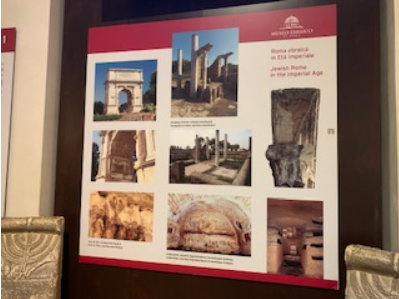At the beginning of 2023, we walked in the eternal city bathed in sunlight with our family members. With the firm determination to visit the central synagogue (Tempio Maggiore di Roma) and museum rising on the banks of the Tevere in the quiet of the beginning of the year, we will walk along Piazza Gerusalemme. The largest of the 19 synagogues in Rome, it preserves the uplifting and dramatic memories of nearly 2,200 years of Jewish presence with its majestic silence.
One thing is certain: Jews and Christians, Romans and Israelis agree that "Rome is the only city in Europe from which the Jews were never expelled" (quote from the inscription on the wall of the Jewish Museum in Rome, entitled: Judaism through the ages). This museum-walk, reflection, recollection of the past, space-time physical and transphysical journey will remain with us even deeper than the Vatican holiday impressions. You can read my thanks at the end of the article, in which the special coexistence of the two world religions with common roots, Judaism and Christianity, can be felt. This is no longer a pun: Jerusalem in Rome - Rome in Jerusalem.
The first contact between Rome and Judaism dates back to the 160s BC. Then, according to the tradition of the Book of Maccabees, Eupolemus, son of John, and Jason, son of Eleazar, appeared before the Roman Senate. They were sent by Judas Maccabeus (190-160 BC), the military leader of the national revolt against Greek rule in the land of Israel. According to tradition, the two embassies were guests of Jews, merchants and freedmen living in Rome.
The Jewish presence in Rome was further strengthened when, during Pompeius's campaign and during his campaign against Judea (63-61 BC), a good part of the captured soldiers were brought to the city of Rome. Their number continued to increase when Vespasian and Titus in 70 AD won and took away the remaining independence of the Jews and destroyed the heart of their religious life, the Temple in Jerusalem. The reliefs of the historian Flavius Josephus and the triumphal arch of Titus prove that the Romans brought the slaves and the treasures of the destroyed temple, including the golden Menorah and the candlestick, from conquered Judea, „Judea Capta” in the capital of the Roman Empire. Vespasian levied the fiscus judaicus, the half-shekel tax that all Jews had to pay into the treasury, instead of the tithe that was no longer due, in favor of the destroyed temple.
During the Roman Empire, the Jewish community increased in Rome. They gained more and more influence among officials, teachers, and rabbis. There were many craftsmen and merchants among them, but also people of culture, such as Mattia ben Cherest, the head of the famous yeshiva, school, and rabbinic training academy in the second century. In those days, there were already 12 synagogues in Rome, today there are 19.
Ancient writers and poets, Ovid, Tibullus, Tacitus, and Juvenal already wrote about certain Jewish customs, such as the Sabbath, although they were not aware of its true significance. Sventonius drew the attention of the Jews to attend the funeral of Julius Caesar, who had defended them.
Like other religious groups, Jews were fully accepted in the Roman Empire as long as they did not cause confusion or other problems. However, in AD 49, when the Jews could not yet be sharply distinguished from the early Christians, Emperor Claudius ordered the expulsion of some of them from Rome as a result of riots in the center of the empire caused by the Impulse Chresto, i.e. the Christians.
In 132 AD, Emperor Hadrian repressed attempts at Jewish resistance in the land of Israel and forbade Jews to perform circumcision and study the Holy Scriptures. Later these sacral rights were restored.
The Talmud attests that many Jewish sages visited Rome, such as Rabbi Gamaliel, Shimon bar Yochai, Eliezer benYose. They wrote about the city in a very specific way, with suspicion and wonder at the same time: "The world has ten values on earth, nine of which are in Rome, and only one in the rest of the world" (Ester Rabba).
Rabbi Yeoshua ben Levi also observed that in Rome the pillars are covered with tapestry against the cold and heat, but the poor are given only straw bricks. This was order and justice in Rome. But the rabbis also found that basic solidarity with the unfortunate only really works according to tzedakah, the biblical measure of justice, and mostly only in Judaism. The poignant thing is that when the Jews were still firmly at home in the land of Israel, Rabbi Dimi wrote: “The Romans fought 32 battles against the Greeks without success, until they saw, recognized that they had to make an alliance with the Jews."
In the Imperium Romanum, the Roman Empire, Christianity became the state religion from the fourth century. Persecution for the murder of Jesus and anti-Christian conspiracies continued in Europe throughout the Middle Ages. But from the second century to the present, Rome has remained the only tolerant city in Europe from which no Jewish person or family has ever been persecuted for their religion or beliefs. While in Spain in 1492 their expulsion became national. In Venice and Italy, from 1516, a year before the outbreak of the Reformation, the first ghettos, the Jewish quarters, were designated where they could live. The Roman ghetto was established in 1555. In Ostia, a coastal port city near Rome, they already had a beautiful synagogue in ancient times.
Jewish culture in Rome
Here in the museum you can see the precious gold, silver, precious stones, precious metals, and many kinds of brocade blankets, which survived from the offerings of various noble Jewish families as material evidence of the richness of their cultic life. Menorahs, readers, pictures, paintings and sacred objects related to different periods of cultic occasions, biblical themed paintings and all kinds of Torah holders fill the halls. The colorful world of stars of David and letters that vary lavishly in geometric shapes offers enough attractions for days. In Rome, Jewish culture was present with the most diverse editions of the Bible and excellent rabbis.
In 1165, Benjamin of Tudela described the city's Jews as those who, with their strong sense of identity, contributed to the development of intellectual life in Rome. They represented a high cultural level in philosophy, biblical studies, astronomy, medicine and mathematics. Immanuel Rome was a contemporary of Dante and wrote a great Hebrew poem, the Mahbarot, in the style of the Divine Comedy. The world's first printed book in Hebrew was probably first published in Rome. The talisman also had a long tradition of researching the meaning of Hebrew letters and words with amazing associations.
Menorah as blooming thanks to God, Jesus the lamb and the 18 blessings
Two objects in particular attract attention. One is a Menorah, a candlestick that the artist made of stylized blossoming almond tree branches with silver, gold, diamonds, rubies and other materials. It was prepared in Paris for the exhibition organized simultaneously in the Jewish Museum of Rome and the Vatican Museum in 2017. Topic: The history, cultic role and myth of the Menorah. I saw and felt that despite thousands of years of biblical belief, the splendor and good fragrance of spring flowers is revealed before God in this strange Menorah creation, which is beautiful regardless of the season, year and place. All believers, whether Jewish or Christian, can feel the gratitude expressed in it. This is the Menorah, the primavera, the eternal source of gratitude. Almond blossom of the redeemed.
The other work is the painting in which a sacrificial lamb faces us. Through his eyes, it is as if the eyes of the Crucified Jesus are fixed on our souls. Very deeply and inescapably. The Menorah and the Lamb, the Piazza Gerusalemme and the great synagogue in Rome engraved deeply in my soul the lines of the Amida, the 18 blessings, which will sound deep in my heart in 2023 and perhaps for the rest of my life, like the sounds of the Shofar. These are the lines asking for blessing:
„May the Lord, who protected our fathers, protect us./ May the Lord give us life and help us all./ The Lord is holy./ May the Lord grant us intelligence and knowledge./ May He return us to the observance of His Law./ May He forgive our sins./ May He help us./ May He heal us from all infirmity./ May He bless our work and make us prosper./ May He soon announce our freedom./ May He re-establish His judges and reign over us./ May He remove all hope from the evil-doers. / May He give help to the righteous./ May He soon return to Jerusalem. / May He bring the Messiah, the bearer of salvation./ May G-d hear our voice and accept our prayer./ May He return the divine service to His house./ Thanks be to G-d for the all the miracles He works for us./ May He grant His peace to his people, now and forever”.
As a follower of Jesus Christ, Son of David, all I could say then and there, here and now, is: Amen.
Hommage à Menorah
OH, MENORAH,
in you, despite thousands of years,
the splendor of spring flowers and the good fragrance of the biblical faith
is revealed regardless of the season, years, place as thanks,
thanks for everything to God, our God, from you, you strange, wonderful creation.
As from the heart of every believer, whether Jew or Christian.
This is the Menorah, the primavera of gratitude,
the eternally renewing and renewing spring of faith.
Almond blossom of the redeemed.
Blessed be you with your flowerfingers open to the sky,
pointing to the Eternal One,
the Ineffable Eternal One who was, is, and is to come.
You prayerful Menorah,
be blessed
from generation to generation












